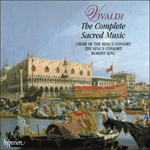
Welcome to Hyperion Records, an independent British classical label devoted to presenting high-quality recordings of music of all styles and from all periods from the twelfth century to the twenty-first.
Hyperion offers both CDs, and downloads in a number of formats. The site is also available in several languages.
Please use the dropdown buttons to set your preferred options, or use the checkbox to accept the defaults.

Its text, written in the highly Italianate Latin of the time, associates it with the celebration of the feast of the Assumption of the Blessed Virgin Mary on 15 August. The opening aria describes how Mary joyfully ascends mountains and hills, this ascent being an Arcadian metaphor for her translation to Heaven. In a central recitative the anonymous poet heaps encomiums on Mary, and the final aria exhorts the angels of Paradise, the flowers of the field and the shepherds of the Nativity to join in her praise. This final aria mentions the rustic instruments fistula and tibia (pipe and flute), and Vivaldi accordingly places bagpipe-like drones in the bass and chains of parallel thirds in the treble. The exuberance of this simple but by no means facile work makes the perfect hors d’oeuvre to the opening psalm of Vespers.
from notes by Michael Talbot © 2003
Ecrit dans le latin hautement italianisé de l’époque, son texte s’associe aux célébrations de la fête de l’Ascension de la Vierge Marie, le 15 août. L’aria initiale décrit comment Marie fait joyeusement l’ascension des collines et des montagnes, celle-ci étant une métaphore arcadienne de son élévation vers les cieux. Dans un récitatif central, le poète anonyme la comble de louanges. L’aria finale évoque des instruments champêtres comme la fistula et la tibia (pipeau et flûte), si bien que Vivaldi place des bourdons de cornemuses aux basses et des mouvements en tierces parallèles aux dessus. L’exubérance de cette page simple, mais nullement facile, fait œuvre de parfait préambule au psaume des Vêpres.
extrait des notes rédigées par ©
Der Text, der in dem hoch italienisierten Latein der Zeit verfasst ist, bringt das Werk in Verbindung mit dem Fest Mariä Himmelfahrt am 15. August. In der ersten Arie wird beschrieben, wie Maria fröhlich Hügel und Berge emporsteigt, eine arkadische Metapher für ihre Himmelfahrt. In einem zentralen Rezitativ überhäuft der anonyme Dichter Maria geradezu mit Lobreden und ermahnt in der letzten Arie die Engel des Paradieses, die Blumen auf den Feldern und die Hirten der Geburt Christi dazu, an ihrer Bejubelung teilzunehmen. In dieser letzten Arie ist außerdem die Rede von den bäuerlichen Instrumenten fistula und tibia (Rohrpfeife und Flöte) und Vivaldi verlangt entsprechend einen dudelsackähnlichen Bordunton im Bass und Terzketten in der Oberstimme. Der Überschwang dieses schlichten aber keineswegs einfachen Werks ist als hors d’oeuvre des ersten Vesperpsalms sehr passend.
aus dem Begleittext von Michael Talbot © 2003
Deutsch: Viola Scheffel
 Vivaldi: The Complete Sacred Music Vivaldi: The Complete Sacred Music‘For King's sterling service to the Vivaldian cause, one of his most important recording and satisfying projects to date, I am thankful’ (Gramophone) ‘If you're waiting for the perfect collection of Vivaldi's sacred music, this is it. It was a happy day when this beautiful boxed set arrived in my m ...» More |

